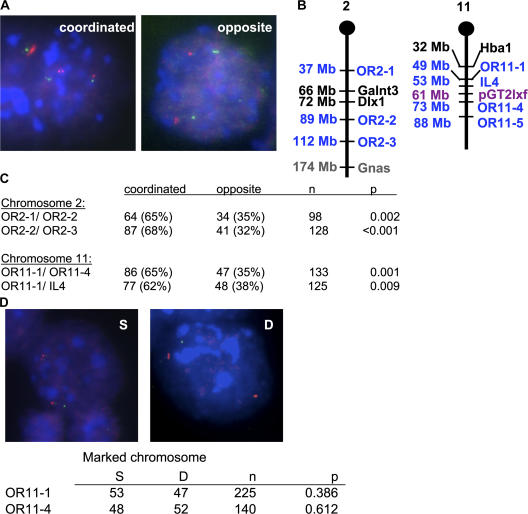Figure 2.
SIAR of autosomal genes is coordinated and switchable. (A) Appearance of random monoallelic loci as SD FISH signals is coordinated along the length of a chromosome. Representative FISH images of cells displaying coordinated or opposite SD signals for pairs of OR probes on the same chromosome. DNA-FISH was performed on wild-type ES cells using the OR probes OR11-1 (left) or OR2-3 (right) labeled with Cy3 (red), and OR11-4 (left) or OR2-2 (right) labeled with biotin and detected with FITC-avidin (green). DNA was stained with DAPI (blue). (B) Locations of loci examined on chromosomes 2 and 11. OR arrays are named according to the system of Zhang and Firestein (2002). Random monoallelic genes are labeled in blue, biallelic genes in black, imprinted genes in gray, and the chromosome 11 transgene used as a marker in violet. (C) Quantitation of the percentage of cells displaying coordinated or opposite SD signals for four pairs of probes. A χ-square test was used to determine P values for coordination, with a null hypothesis of no coordination. (D) The identities of the singlet and doublet alleles are not fixed in ES cells. Representative FISH images of cells from a clonal population displaying a singlet or doublet signal on a marked chromosome. Combined RNA/DNA-FISH was performed on ES cells carrying a transgene on one copy of chromosome 11 (BayGenomics line RRR379) using the OR probes OR11-1 labeled with Cy3 (red), and plasmid pGT2lxf labeled with FITC (green). Because OR genes are not expressed in ES cells, these probes detected DNA only; the pGT2lxf probe detected both RNA and DNA. The frequency of SD FISH signals for each probe by itself in RRR379 ES cells was comparable to that in wild-type male (E14) or female (ES2-1) ES cells (not depicted). DNA was stained with DAPI (blue). Quantitation of the percentage of cells displaying a singlet or doublet signal for the OR11-1 or OR11-4 probe on the pGT2lxf-containing chromosome are given in the table below. A χ-square test was used to determine P values, with a null hypothesis of a locus on the marked chromosome being equally likely to appear as a singlet or a doublet.

